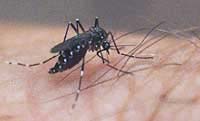Making a Friendlier Mosquito

Researchers say genetically modifying mosquitos that can’t transmit malaria may help suppress the disease. (Debbie Aldridge/UC Davis photo)
Genetically modified mosquitoes that cannot transmit malaria are one hope for battling the disease that still kills over one million people a year. But that plan faces some serious snags, according to UC Davis researchers who are suggesting an alternative strategy.
Other scientists have proposed controlling malaria by releasing into the wild mosquitoes genetically engineered to resist malaria. If the resistant mosquitoes breed and spread their genes through the population, malaria transmission should be shut down. The malaria parasite depends entirely on female Anopheles mosquitoes to spread from person to person.
That plan faces two problems, say postdoctoral researcher Matthew Hahn and Sergey Nuzhdin, a professor of evolution and ecology at UC Davis. First, the malaria resistance genes available are not very effective. Second, there’s no way to reliably push the genes through the population.
To put genes into an insect, scientists use a mobile piece of DNA called a transposon. Transposons are essentially DNA parasites that snip themselves in or out of the genome under the right circumstances. Scientists can add a new gene into a transposon and use it to carry that DNA into the insect genome. But it’s in the interest of that transposon to just get rid of the extra DNA, Hahn said.
Hahn and Nuzhdin propose an alternative strategy. They suggest designing a transposon that gives an advantage to mosquitoes that already carry genes to block malaria, so that those genes spread through the population by natural selection.
The genetic engineering work involved is challenging but should be possible, Hahn said.
The work is published in the April 6 issue of the journal Current Biology.
Media Contact
More Information:
http://www.news.ucdavis.edu/search/news_detail.lasso?id=6993All latest news from the category: Life Sciences and Chemistry
Articles and reports from the Life Sciences and chemistry area deal with applied and basic research into modern biology, chemistry and human medicine.
Valuable information can be found on a range of life sciences fields including bacteriology, biochemistry, bionics, bioinformatics, biophysics, biotechnology, genetics, geobotany, human biology, marine biology, microbiology, molecular biology, cellular biology, zoology, bioinorganic chemistry, microchemistry and environmental chemistry.
Newest articles

Bringing bio-inspired robots to life
Nebraska researcher Eric Markvicka gets NSF CAREER Award to pursue manufacture of novel materials for soft robotics and stretchable electronics. Engineers are increasingly eager to develop robots that mimic the…

Bella moths use poison to attract mates
Scientists are closer to finding out how. Pyrrolizidine alkaloids are as bitter and toxic as they are hard to pronounce. They’re produced by several different types of plants and are…

AI tool creates ‘synthetic’ images of cells
…for enhanced microscopy analysis. Observing individual cells through microscopes can reveal a range of important cell biological phenomena that frequently play a role in human diseases, but the process of…





















